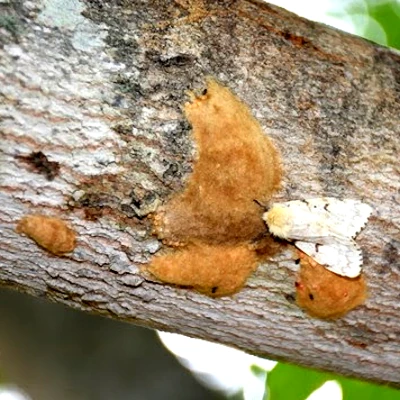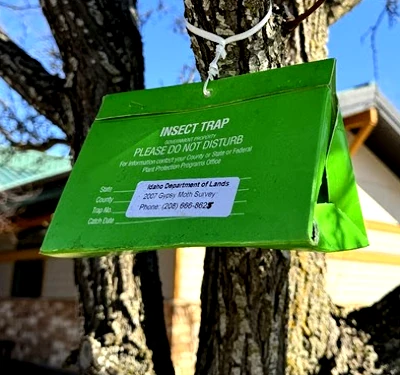
The Invasive Spongy Moth was detected in Sandpoint for the first time in more than 30 years. The Idaho Department of Lands (IDL), in collaboration with the Idaho State Department of Agriculture (ISDA) and the USDA Forest Service (USFS), conducts extensive annual monitoring to identify new introductions. This includes placing thousands of traps throughout the state. These traps feature sticky inner walls and utilize a pheromone lure that mimics a female moth to attract males. The traps are deployed statewide during the moths’ flight period in summer and are collected in the fall for evaluation.
The spongy moth was formerly known as the gypsy moth until its name was changed by the Entomological Society of America in 2021. The new name reflects its spongy egg masses, aligning with the French common name for the species (spongieuse).
A spongy moth trap located near the intersection of Oak Street and Division Street in Sandpoint captured a single male moth strongly resembling a spongy moth. The specimen was quickly sent to the Animal and Plant Health Inspection Service (APHIS) for DNA confirmation, which confirmed it as the European spongy moth. Relevant authorities were promptly notified of the detection. Most likely, this moth was accidentally introduced by someone traveling to Idaho from an infested state in the eastern US. Spongy moths (especially their egg masses) can hitchhike on materials like firewood, campers, outdoor furniture, and even vehicles.
Lymantria dispar dispar was introduced into the eastern US in 1869 and is now established in about 20 northeastern and midwestern states. European spongy moth feeds on the leaves of various broadleaved trees and shrubs, particularly oak trees. Outbreaks can lead to significant damage costing millions of dollars. European spongy moth has limited dispersal capabilities because the female moths cannot fly, so new introductions are often caused by humans moving infested materials to new locations.

Since its inception in 1974, the Idaho spongy moth trapping program has captured spongy moths in many Idaho cities and has successfully eradicated spongy moth from the state multiple times. The last time spongy moths were captured in Sandpoint was between 1986 and 1990. At the peak, 334 moths were captured in Sandpoint in 1988. The population was successfully eradicated by 1991. Traps are placed in Sandpoint every year at a density of one trap per square mile, and no additional spongy moths have been captured in Sandpoint until this year.
A single moth capture does not usually lead to an established population that requires eradication. The next step is to determine whether this incident was a one-off occurrence or if it signifies the beginning of a breeding population. To investigate this, IDL will conduct delimitation trapping in 2025. This will involve placing 36 traps per square mile across the four square miles surrounding the capture site (covering all of the downtown area of Sandpoint). If additional moths are present, this intensive trapping will help outline the extent and severity of the infestation while also reducing the local moth population.
Residents can expect to see numerous bright green or bright orange cardboard traps throughout Sandpoint in the summer of 2025. It is crucial to leave these traps undisturbed to allow for proper monitoring by the Idaho Department of Lands. Removing or vandalizing the traps can hinder data collection on the potential spongy moth population.
“Although capturing an invasive insect is never good news, the Idaho spongy moth trapping program is working as designed to help keep this damaging and expensive pest out of Idaho,” said Erika Eidson, Forest Health Specialist with the Idaho Department of Lands. “We detected this new introduction quickly. Early detection lowers the need for costly, large-scale pest management and improves eradication outcomes.”
Help prevent the spread of spongy moth and other invasive insects: Avoid moving firewood long distances (buy it where you burn it), check outdoor objects for signs of insects before relocating them, and report any suspicious sightings or tree damage to the Idaho Department of Lands.
